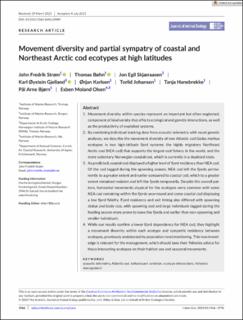| dc.description.abstract | Movement diversity within species represent an important but often neglected, component of biodiversity that affects ecological and genetic interactions, as well as the productivity of exploited systems. By combining individual tracking data from acoustic telemetry with novel genetic analyses, we describe the movement diversity of two Atlantic cod Gadus morhua ecotypes in two high-latitude fjord systems: the highly migratory Northeast Arctic cod (NEA cod) that supports the largest cod fishery in the world, and the more sedentary Norwegian coastal cod, which is currently in a depleted state. As predicted, coastal cod displayed a higher level of fjord residency than NEA cod. Of the cod tagged during the spawning season, NEA cod left the fjords permanently to a greater extent and earlier compared to coastal cod, which to a greater extent remained resident and left the fjords temporarily. Despite this overall pattern, horizontal movements atypical for the ecotypes were common with some NEA cod remaining within the fjords year-round and some coastal cod displaying a low fjord fidelity. Fjord residency and exit timing also differed with spawning status and body size, with spawning cod and large individuals tagged during the feeding season more prone to leave the fjords and earlier than non-spawning and smaller individuals. While our results confirm a lower fjord dependency for NEA cod, they highlight a movement diversity within each ecotype and sympatric residency between ecotypes, previously undetected by population-level monitoring. This new knowledge is relevant for the management, which should base their fisheries advice for these interacting ecotypes on their habitat use and seasonal movements. | |
